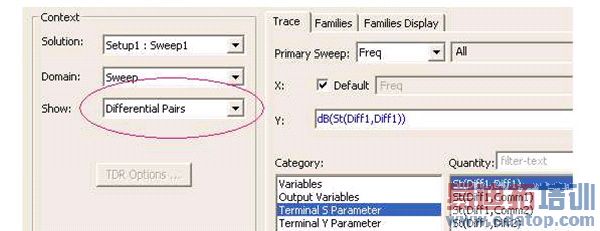- 易迪拓培训,专注于微波、射频、天线设计工程师的培养
HFSS15: Context Section for Reports
In the Context section make selections from the following field or fields, depending on the design and solution type.
1. Solution field with a drop down selection list. This lists the available solutions, whether sweeps or adaptive passes. The selections for HFSS Transient include Transient, and for Transient Network includes Spectral.
2. Domain field with a drop down selection list. Whether this field appears, and the domains listed depend on the Solution type and the <type> selected. For modal and terminal solution data r reports, the domain can be Sweep or Time.
Before you can examine the time domain, you must perform an Interpolating sweep for a driven solution (Modal or Terminal). If you select Time, the TDR Options button is enabled. Select it and follow the directions for time-domain plotting.
3. Geometry field with a drop down selection list. For field and radiated field reports, this applies the quantity to a geometry or radiated field setup.
4. Show field with a drop down selection list for Differential pairs or Terminals. This field appears for designs using terminal solutions that have differential pairs defined. It lets you plot either differential pair data, or single-ended terminal data, or both in the same plot without having to disable or enable differential pairs under the Excitations heading in the Project tree. Note that single-ended quantities are computed as if no differential pairs existed. So in the unlikely case of several terminals where only a subset is combined into pairs, the results may not be as expected.

5. Derivative field with a drop drown selection list of none, all, and specific variables for which you specified Use on the Derivatives tab of the solution setup. You can use derivatives in some Optimetrics situations, and with the Derivative Tuning feature in the Reporter.
6. A Sources combo box appears in the Reporter when you have specified at least one source in the Edit Sources dialog. See Specifying Source Contexts for Creating Radiated Field Reports. For an example use, see User Defined Solution for MIMO Calculations.
HFSS 学习培训课程套装,专家讲解,视频教学,帮助您全面系统地学习掌握HFSS
上一篇:Computing Differential Pairs
下一篇:Computing Maximum Near-Field Parameters


